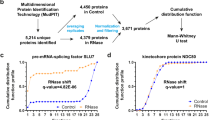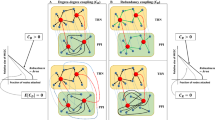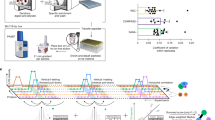Abstract
Plasmodium falciparum is the pathogen responsible for over 90% of human deaths from malaria1. Therefore, it has been the focus of a considerable research initiative, involving the complete DNA sequencing of the genome2, large-scale expression analyses3,4, and protein characterization of its life-cycle stages5. The Plasmodium genome sequence is relatively distant from those of most other eukaryotes, with more than 60% of the 5,334 encoded proteins lacking any notable sequence similarity to other organisms2. To systematically elucidate functional relationships among these proteins, a large two-hybrid study has recently mapped a network of 2,846 interactions involving 1,312 proteins within Plasmodium6. This network adds to a growing collection of available interaction maps for a number of different organisms, and raises questions about whether the divergence of Plasmodium at the sequence level is reflected in the configuration of its protein network. Here we examine the degree of conservation between the Plasmodium protein network and those of model organisms. Although we find 29 highly connected protein complexes specific to the network of the pathogen, we find very little conservation with complexes observed in other organisms (three in yeast, none in the others). Overall, the patterns of protein interaction in Plasmodium, like its genome sequence, set it apart from other species.
This is a preview of subscription content, access via your institution
Access options
Subscribe to this journal
Receive 51 print issues and online access
$199.00 per year
only $3.90 per issue
Buy this article
- Purchase on Springer Link
- Instant access to full article PDF
Prices may be subject to local taxes which are calculated during checkout




Similar content being viewed by others
References
Miller, L. H., Baruch, D. I., Marsh, K. & Doumbo, O. K. The pathogenic basis of malaria. Nature 415, 673–679 (2002)
Gardner, M. J. et al. Genome sequence of the human malaria parasite Plasmodium falciparum. Nature 419, 498–511 (2002)
Bozdech, Z. et al. The transcriptome of the intraerythrocytic developmental cycle of Plasmodium falciparum. PLoS Biol. 1, E5 (2003)
Le Roch, K. G. et al. Discovery of gene function by expression profiling of the malaria parasite life cycle. Science 301, 1503–1508 (2003)
Florens, L. et al. A proteomic view of the Plasmodium falciparum life cycle. Nature 419, 520–526 (2002)
LaCount, D. J. et al. A protein interaction network of the malaria parasite Plasmodium falciparum. Nature doi:10.1038/nature04104 (this issue)
Conant, G. C. & Wagner, A. Convergent evolution of gene circuits. Nature Genet. 34, 264–266 (2003)
Yu, H. et al. Annotation transfer between genomes: protein–protein interologs and protein–DNA regulogs. Genome Res. 14, 1107–1118 (2004)
Sharan, R. et al. Conserved patterns of protein interaction in multiple species. Proc. Natl Acad. Sci. USA 102, 1974–1979 (2005)
Kelley, B. P. et al. Conserved pathways within bacteria and yeast as revealed by global protein network alignment. Proc. Natl Acad. Sci. USA 100, 11394–11399 (2003)
Xenarios, I. et al. DIP, the Database of Interacting Proteins: a research tool for studying cellular networks of protein interactions. Nucleic Acids Res. 30, 303–305 (2002)
Li, S. et al. A map of the interactome network of the metazoan C. elegans. Science 303, 540–543 (2004)
Giot, L. et al. A protein interaction map of Drosophila melanogaster. Science 302, 1727–1736 (2003)
Rain, J. C. et al. The protein–protein interaction map of Helicobacter pylori. Nature 409, 211–215 (2001)
Felsenstein, J. PHYLIP—phylogeny inference package (version 3.2). Cladistics 5, 164–166 (1989)
Barabasi, A. L. & Oltvai, Z. N. Network biology: understanding the cell's functional organization. Nature Rev. Genet. 5, 101–113 (2004)
Shanmugam, K. S. Digital and Analog Communication Systems (Wiley, New York, 1979)
Gagny, B. et al. A novel EH domain protein of Saccharomyces cerevisiae, Ede1p, involved in endocytosis. J. Cell Sci. 113, 3309–3319 (2000)
Engqvist-Goldstein, A. E. & Drubin, D. G. Actin assembly and endocytosis: from yeast to mammals. Annu. Rev. Cell Dev. Biol. 19, 287–332 (2003)
Goodson, H. V., Anderson, B. L., Warrick, H. M., Pon, L. A. & Spudich, J. A. Synthetic lethality screen identifies a novel yeast myosin I gene (MYO5): myosin I proteins are required for polarization of the actin cytoskeleton. J. Cell Biol. 133, 1277–1291 (1996)
Salisbury, J. L., Condeelis, J. S., Maihle, N. J. & Satir, P. Calmodulin localization during capping and receptor-mediated endocytosis. Nature 294, 163–166 (1981)
Scheibel, L. W. et al. Calcium and calmodulin antagonists inhibit human malaria parasites (Plasmodium falciparum): implications for drug design. Proc. Natl Acad. Sci. USA 84, 7310–7314 (1987)
Sanchez, C. P., McLean, J. E., Stein, W. & Lanzer, M. Evidence for a substrate specific and inhibitable drug efflux system in chloroquine resistant Plasmodium falciparum strains. Biochemistry 43, 16365–16373 (2004)
Hoppe, H. C. et al. Antimalarial quinolines and artemisinin inhibit endocytosis in Plasmodium falciparum. Antimicrob. Agents Chemother. 48, 2370–2378 (2004)
Langst, G. & Becker, P. B. Nucleosome mobilization and positioning by ISWI-containing chromatin-remodeling factors. J. Cell Sci. 114, 2561–2568 (2001)
Sollars, V. et al. Evidence for an epigenetic mechanism by which Hsp90 acts as a capacitor for morphological evolution. Nature Genet. 33, 70–74 (2003)
Gavin, A. C. et al. Functional organization of the yeast proteome by systematic analysis of protein complexes. Nature 415, 141–147 (2002)
Ashburner, M. et al. Gene ontology: tool for the unification of biology. The Gene Ontology Consortium. Nature Genet. 25, 25–29 (2000)
Uetz, P. et al. A comprehensive analysis of protein–protein interactions in Saccharomyces cerevisiae. Nature 403, 623–627 (2000)
Mewes, H. W. et al. MIPS: analysis and annotation of proteins from whole genomes. Nucleic Acids Res. 32, D41–D44 (2004)
Acknowledgements
We are indebted to M. Vignali, D. LaCount and S. Fields at the University of Washington, and B. Hughes and S. Sahasrabudhe at Prolexys, for providing us with advance access to the Plasmodium interaction data and for suggestions on our manuscript. We also thank E. Winzeler and J. Vinetz for advice on Plasmodium protein function, R. Sharan for help with the PathBLAST algorithm, and V. Bafna for assistance with the false-positive analysis. Finally, we acknowledge the following funding support: the National Science Foundation (S.S.); the National Institute of General Medical Sciences (T.I.); a David and Lucille Packard Fellowship award (T.I.); the Howard Hughes Medical Institute (T.S.); and Unilever (T.S.). Author Contributions S.S. and T.S. contributed equally to this work. All authors discussed the results and wrote the paper.
Author information
Authors and Affiliations
Corresponding author
Ethics declarations
Competing interests
Reprints and permissions information is available at npg.nature.com/reprintsandpermissions. The authors declare no competing financial interests.
Supplementary information
Supplementary Notes
This file contains the Supplementary Methods, Supplementary Figures 1–3 and Supplementary Tables 1–7. (DOC 1636 kb)
Rights and permissions
About this article
Cite this article
Suthram, S., Sittler, T. & Ideker, T. The Plasmodium protein network diverges from those of other eukaryotes. Nature 438, 108–112 (2005). https://doi.org/10.1038/nature04135
Received:
Accepted:
Issue Date:
DOI: https://doi.org/10.1038/nature04135
This article is cited by
-
PROPER: global protein interaction network alignment through percolation matching
BMC Bioinformatics (2016)
-
Predicting and exploring network components involved in pathogenesis in the malaria parasite via novel subnetwork alignments
BMC Systems Biology (2015)
-
A bioinformatic survey of RNA-binding proteins in Plasmodium
BMC Genomics (2015)
-
Computational Models for Neglected Diseases: Gaps and Opportunities
Pharmaceutical Research (2014)
-
A novel subnetwork alignment approach predicts new components of the cell cycle regulatory apparatus in Plasmodium falciparum
BMC Bioinformatics (2013)
Comments
By submitting a comment you agree to abide by our Terms and Community Guidelines. If you find something abusive or that does not comply with our terms or guidelines please flag it as inappropriate.



